University of Mauritius Research: SMEs Collaboration Economic Growth
VerifiedAdded on 2022/01/21
|31
|9467
|44
Report
AI Summary
This research paper, published in the University of Mauritius Research Journal in 2015, investigates the collaboration between the University of Mauritius and Small and Medium Enterprises (SMEs) to foster economic growth in Mauritius, a Small Island Developing State (SIDS). The study highlights the significant contribution of SMEs to the Mauritian economy and the challenges they face, including limited access to technology, financial constraints, and market limitations. The paper proposes that universities can play a crucial role in supporting SMEs by designing low-cost equipment tailored to their specific needs. It discusses two projects undertaken by the University of Mauritius as examples of successful collaboration, emphasizing the need for coordination between universities, SMEs, linking institutions, and funding bodies. The research also delves into the definition and development of SMEs in Mauritius, the problems they encounter, and the potential for university-SME partnerships to address these issues, ultimately contributing to job creation, innovation, and economic expansion. The paper underscores the importance of custom-designed equipment and the benefits of collaboration, especially in SIDS contexts where local market viability and export competitiveness are crucial.
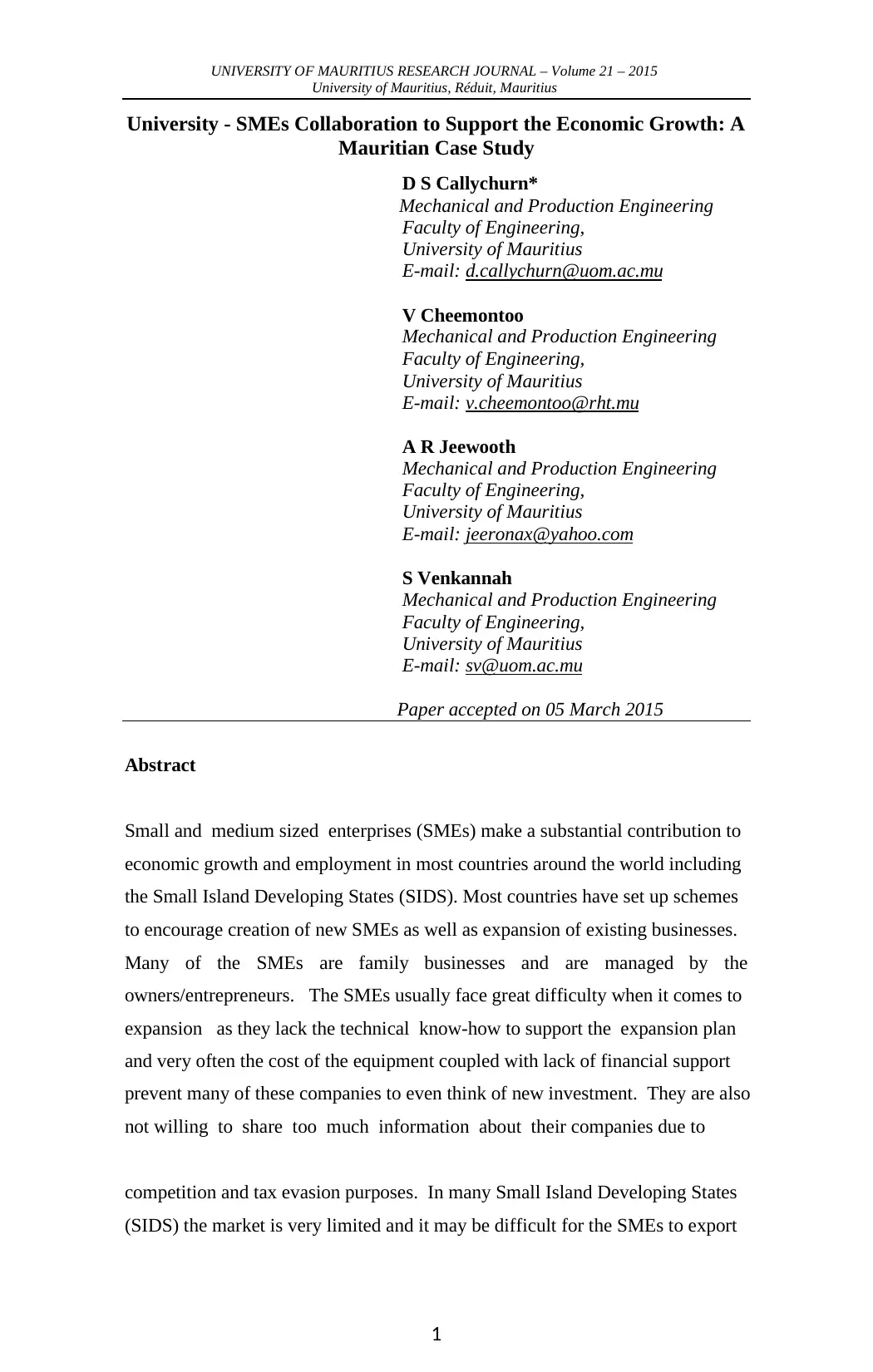
UNIVERSITY OF MAURITIUS RESEARCH JOURNAL – Volume 21 – 2015
University of Mauritius, Réduit, Mauritius
1
University - SMEs Collaboration to Support the Economic Growth: A
Mauritian Case Study
Paper accepted on 05 March 2015
Abstract
Small and medium sized enterprises (SMEs) make a substantial contribution to
economic growth and employment in most countries around the world including
the Small Island Developing States (SIDS). Most countries have set up schemes
to encourage creation of new SMEs as well as expansion of existing businesses.
Many of the SMEs are family businesses and are managed by the
owners/entrepreneurs. The SMEs usually face great difficulty when it comes to
expansion as they lack the technical know-how to support the expansion plan
and very often the cost of the equipment coupled with lack of financial support
prevent many of these companies to even think of new investment. They are also
not willing to share too much information about their companies due to
competition and tax evasion purposes. In many Small Island Developing States
(SIDS) the market is very limited and it may be difficult for the SMEs to export
D S Callychurn*
Mechanical and Production Engineering
Faculty of Engineering,
University of Mauritius
E-mail: d.callychurn@uom.ac.mu
V Cheemontoo
Mechanical and Production Engineering
Faculty of Engineering,
University of Mauritius
E-mail: v.cheemontoo@rht.mu
A R Jeewooth
Mechanical and Production Engineering
Faculty of Engineering,
University of Mauritius
E-mail: jeeronax@yahoo.com
S Venkannah
Mechanical and Production Engineering
Faculty of Engineering,
University of Mauritius
E-mail: sv@uom.ac.mu
University of Mauritius, Réduit, Mauritius
1
University - SMEs Collaboration to Support the Economic Growth: A
Mauritian Case Study
Paper accepted on 05 March 2015
Abstract
Small and medium sized enterprises (SMEs) make a substantial contribution to
economic growth and employment in most countries around the world including
the Small Island Developing States (SIDS). Most countries have set up schemes
to encourage creation of new SMEs as well as expansion of existing businesses.
Many of the SMEs are family businesses and are managed by the
owners/entrepreneurs. The SMEs usually face great difficulty when it comes to
expansion as they lack the technical know-how to support the expansion plan
and very often the cost of the equipment coupled with lack of financial support
prevent many of these companies to even think of new investment. They are also
not willing to share too much information about their companies due to
competition and tax evasion purposes. In many Small Island Developing States
(SIDS) the market is very limited and it may be difficult for the SMEs to export
D S Callychurn*
Mechanical and Production Engineering
Faculty of Engineering,
University of Mauritius
E-mail: d.callychurn@uom.ac.mu
V Cheemontoo
Mechanical and Production Engineering
Faculty of Engineering,
University of Mauritius
E-mail: v.cheemontoo@rht.mu
A R Jeewooth
Mechanical and Production Engineering
Faculty of Engineering,
University of Mauritius
E-mail: jeeronax@yahoo.com
S Venkannah
Mechanical and Production Engineering
Faculty of Engineering,
University of Mauritius
E-mail: sv@uom.ac.mu
Paraphrase This Document
Need a fresh take? Get an instant paraphrase of this document with our AI Paraphraser
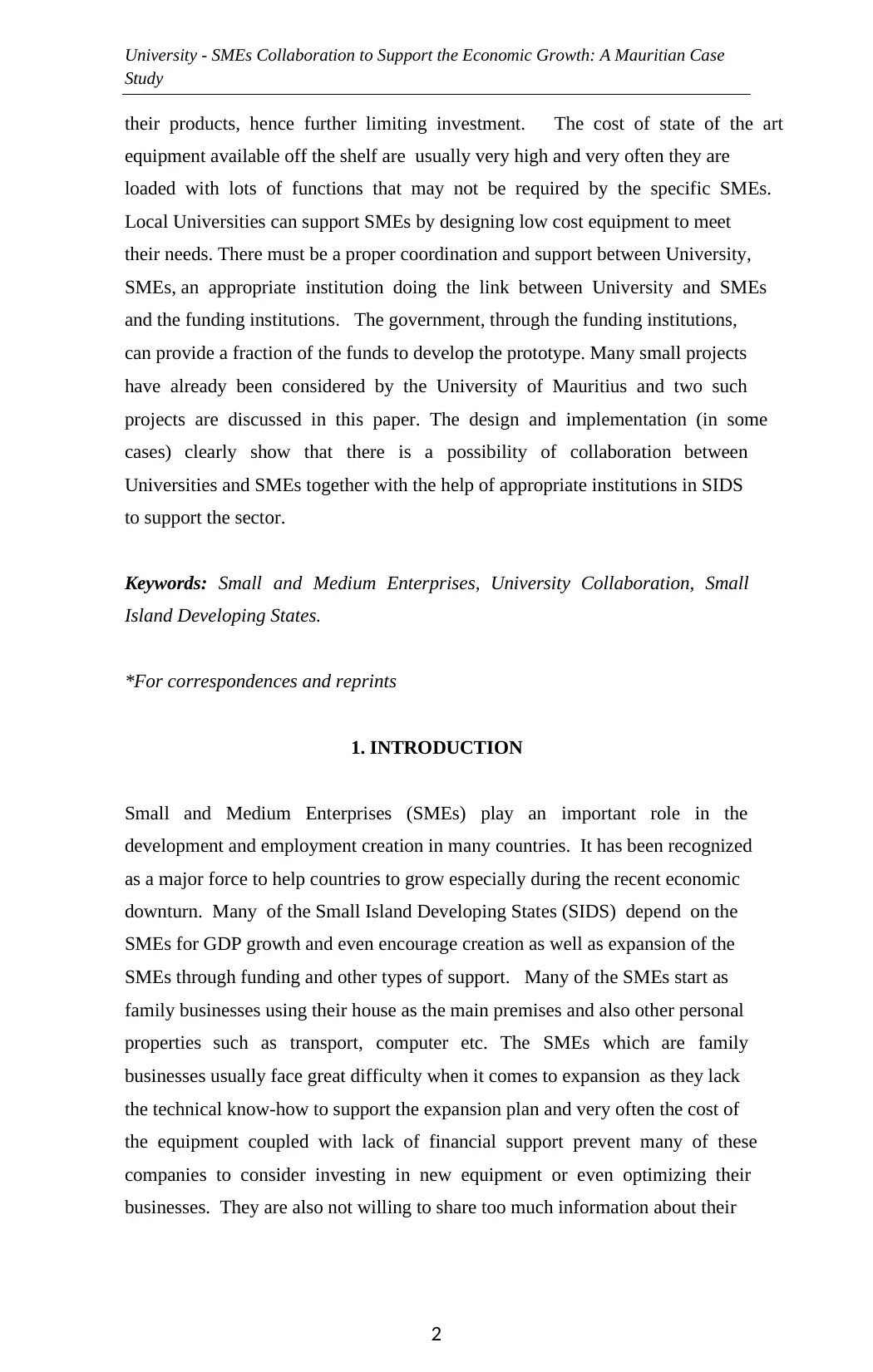
University - SMEs Collaboration to Support the Economic Growth: A Mauritian Case
Study
2
their products, hence further limiting investment. The cost of state of the art
equipment available off the shelf are usually very high and very often they are
loaded with lots of functions that may not be required by the specific SMEs.
Local Universities can support SMEs by designing low cost equipment to meet
their needs. There must be a proper coordination and support between University,
SMEs, an appropriate institution doing the link between University and SMEs
and the funding institutions. The government, through the funding institutions,
can provide a fraction of the funds to develop the prototype. Many small projects
have already been considered by the University of Mauritius and two such
projects are discussed in this paper. The design and implementation (in some
cases) clearly show that there is a possibility of collaboration between
Universities and SMEs together with the help of appropriate institutions in SIDS
to support the sector.
Keywords: Small and Medium Enterprises, University Collaboration, Small
Island Developing States.
*For correspondences and reprints
1. INTRODUCTION
Small and Medium Enterprises (SMEs) play an important role in the
development and employment creation in many countries. It has been recognized
as a major force to help countries to grow especially during the recent economic
downturn. Many of the Small Island Developing States (SIDS) depend on the
SMEs for GDP growth and even encourage creation as well as expansion of the
SMEs through funding and other types of support. Many of the SMEs start as
family businesses using their house as the main premises and also other personal
properties such as transport, computer etc. The SMEs which are family
businesses usually face great difficulty when it comes to expansion as they lack
the technical know-how to support the expansion plan and very often the cost of
the equipment coupled with lack of financial support prevent many of these
companies to consider investing in new equipment or even optimizing their
businesses. They are also not willing to share too much information about their
Study
2
their products, hence further limiting investment. The cost of state of the art
equipment available off the shelf are usually very high and very often they are
loaded with lots of functions that may not be required by the specific SMEs.
Local Universities can support SMEs by designing low cost equipment to meet
their needs. There must be a proper coordination and support between University,
SMEs, an appropriate institution doing the link between University and SMEs
and the funding institutions. The government, through the funding institutions,
can provide a fraction of the funds to develop the prototype. Many small projects
have already been considered by the University of Mauritius and two such
projects are discussed in this paper. The design and implementation (in some
cases) clearly show that there is a possibility of collaboration between
Universities and SMEs together with the help of appropriate institutions in SIDS
to support the sector.
Keywords: Small and Medium Enterprises, University Collaboration, Small
Island Developing States.
*For correspondences and reprints
1. INTRODUCTION
Small and Medium Enterprises (SMEs) play an important role in the
development and employment creation in many countries. It has been recognized
as a major force to help countries to grow especially during the recent economic
downturn. Many of the Small Island Developing States (SIDS) depend on the
SMEs for GDP growth and even encourage creation as well as expansion of the
SMEs through funding and other types of support. Many of the SMEs start as
family businesses using their house as the main premises and also other personal
properties such as transport, computer etc. The SMEs which are family
businesses usually face great difficulty when it comes to expansion as they lack
the technical know-how to support the expansion plan and very often the cost of
the equipment coupled with lack of financial support prevent many of these
companies to consider investing in new equipment or even optimizing their
businesses. They are also not willing to share too much information about their
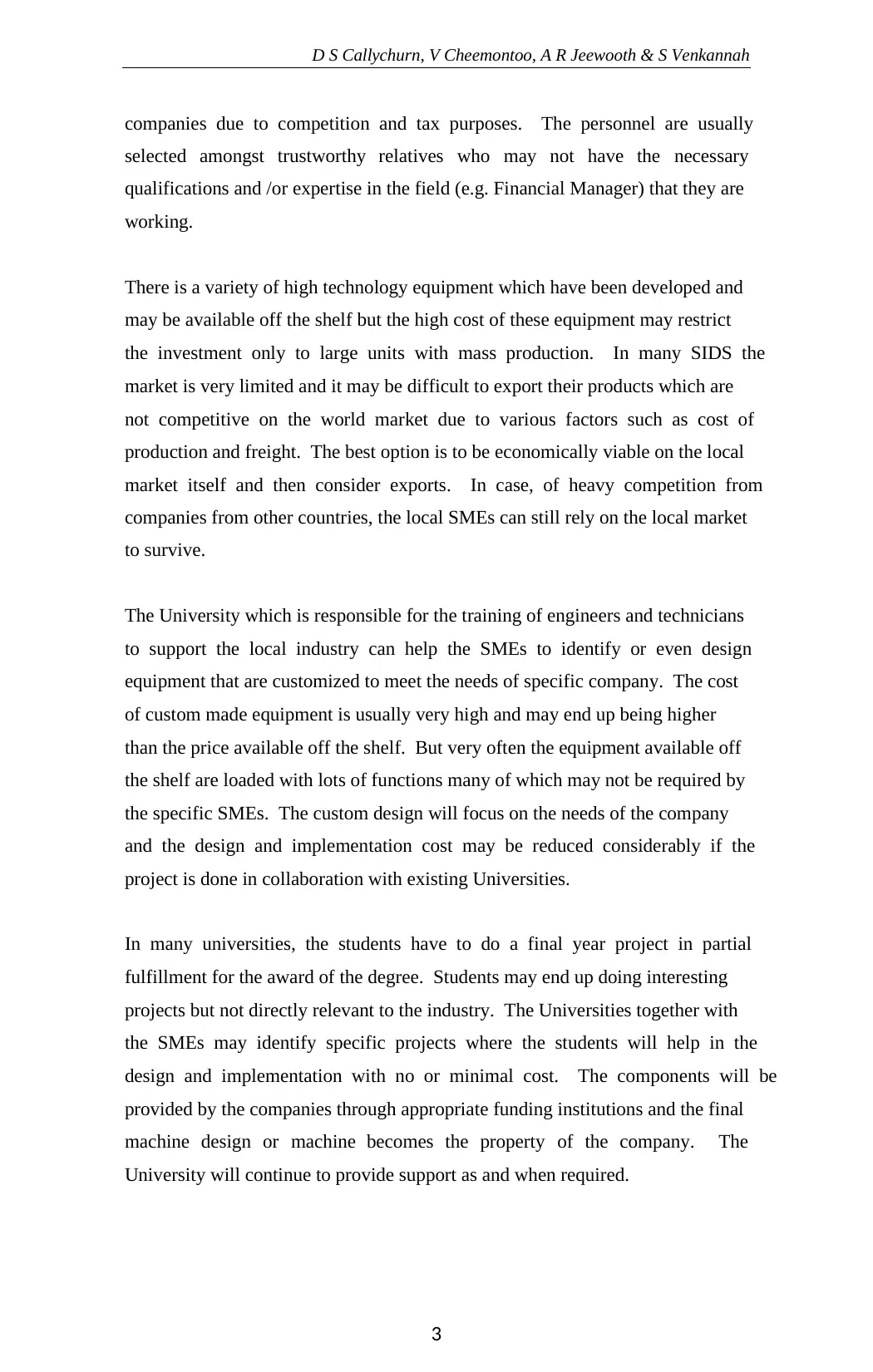
D S Callychurn, V Cheemontoo, A R Jeewooth & S Venkannah
3
companies due to competition and tax purposes. The personnel are usually
selected amongst trustworthy relatives who may not have the necessary
qualifications and /or expertise in the field (e.g. Financial Manager) that they are
working.
There is a variety of high technology equipment which have been developed and
may be available off the shelf but the high cost of these equipment may restrict
the investment only to large units with mass production. In many SIDS the
market is very limited and it may be difficult to export their products which are
not competitive on the world market due to various factors such as cost of
production and freight. The best option is to be economically viable on the local
market itself and then consider exports. In case, of heavy competition from
companies from other countries, the local SMEs can still rely on the local market
to survive.
The University which is responsible for the training of engineers and technicians
to support the local industry can help the SMEs to identify or even design
equipment that are customized to meet the needs of specific company. The cost
of custom made equipment is usually very high and may end up being higher
than the price available off the shelf. But very often the equipment available off
the shelf are loaded with lots of functions many of which may not be required by
the specific SMEs. The custom design will focus on the needs of the company
and the design and implementation cost may be reduced considerably if the
project is done in collaboration with existing Universities.
In many universities, the students have to do a final year project in partial
fulfillment for the award of the degree. Students may end up doing interesting
projects but not directly relevant to the industry. The Universities together with
the SMEs may identify specific projects where the students will help in the
design and implementation with no or minimal cost. The components will be
provided by the companies through appropriate funding institutions and the final
machine design or machine becomes the property of the company. The
University will continue to provide support as and when required.
3
companies due to competition and tax purposes. The personnel are usually
selected amongst trustworthy relatives who may not have the necessary
qualifications and /or expertise in the field (e.g. Financial Manager) that they are
working.
There is a variety of high technology equipment which have been developed and
may be available off the shelf but the high cost of these equipment may restrict
the investment only to large units with mass production. In many SIDS the
market is very limited and it may be difficult to export their products which are
not competitive on the world market due to various factors such as cost of
production and freight. The best option is to be economically viable on the local
market itself and then consider exports. In case, of heavy competition from
companies from other countries, the local SMEs can still rely on the local market
to survive.
The University which is responsible for the training of engineers and technicians
to support the local industry can help the SMEs to identify or even design
equipment that are customized to meet the needs of specific company. The cost
of custom made equipment is usually very high and may end up being higher
than the price available off the shelf. But very often the equipment available off
the shelf are loaded with lots of functions many of which may not be required by
the specific SMEs. The custom design will focus on the needs of the company
and the design and implementation cost may be reduced considerably if the
project is done in collaboration with existing Universities.
In many universities, the students have to do a final year project in partial
fulfillment for the award of the degree. Students may end up doing interesting
projects but not directly relevant to the industry. The Universities together with
the SMEs may identify specific projects where the students will help in the
design and implementation with no or minimal cost. The components will be
provided by the companies through appropriate funding institutions and the final
machine design or machine becomes the property of the company. The
University will continue to provide support as and when required.
⊘ This is a preview!⊘
Do you want full access?
Subscribe today to unlock all pages.

Trusted by 1+ million students worldwide
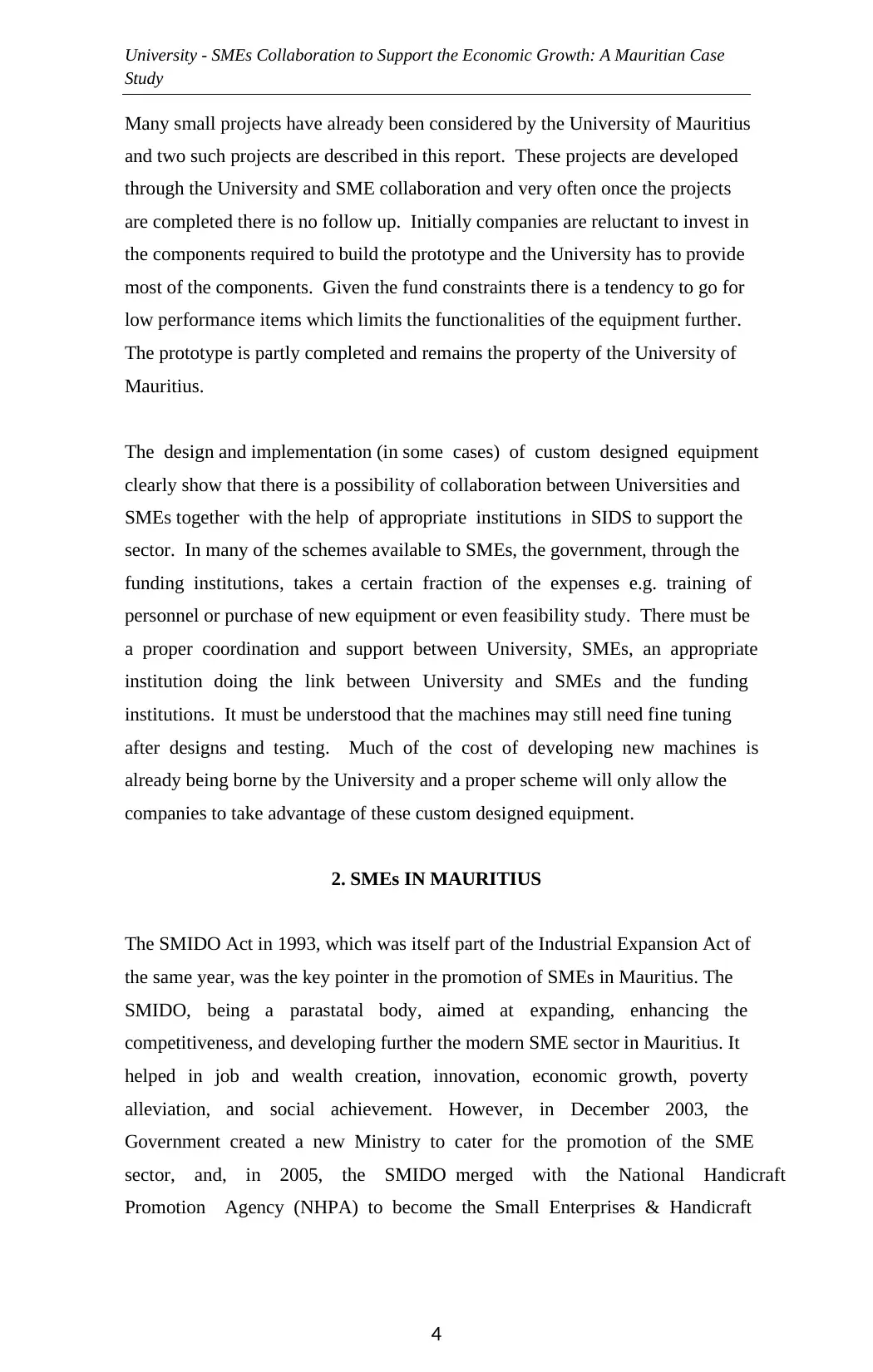
University - SMEs Collaboration to Support the Economic Growth: A Mauritian Case
Study
4
Many small projects have already been considered by the University of Mauritius
and two such projects are described in this report. These projects are developed
through the University and SME collaboration and very often once the projects
are completed there is no follow up. Initially companies are reluctant to invest in
the components required to build the prototype and the University has to provide
most of the components. Given the fund constraints there is a tendency to go for
low performance items which limits the functionalities of the equipment further.
The prototype is partly completed and remains the property of the University of
Mauritius.
The design and implementation (in some cases) of custom designed equipment
clearly show that there is a possibility of collaboration between Universities and
SMEs together with the help of appropriate institutions in SIDS to support the
sector. In many of the schemes available to SMEs, the government, through the
funding institutions, takes a certain fraction of the expenses e.g. training of
personnel or purchase of new equipment or even feasibility study. There must be
a proper coordination and support between University, SMEs, an appropriate
institution doing the link between University and SMEs and the funding
institutions. It must be understood that the machines may still need fine tuning
after designs and testing. Much of the cost of developing new machines is
already being borne by the University and a proper scheme will only allow the
companies to take advantage of these custom designed equipment.
2. SMEs IN MAURITIUS
The SMIDO Act in 1993, which was itself part of the Industrial Expansion Act of
the same year, was the key pointer in the promotion of SMEs in Mauritius. The
SMIDO, being a parastatal body, aimed at expanding, enhancing the
competitiveness, and developing further the modern SME sector in Mauritius. It
helped in job and wealth creation, innovation, economic growth, poverty
alleviation, and social achievement. However, in December 2003, the
Government created a new Ministry to cater for the promotion of the SME
sector, and, in 2005, the SMIDO merged with the National Handicraft
Promotion Agency (NHPA) to become the Small Enterprises & Handicraft
Study
4
Many small projects have already been considered by the University of Mauritius
and two such projects are described in this report. These projects are developed
through the University and SME collaboration and very often once the projects
are completed there is no follow up. Initially companies are reluctant to invest in
the components required to build the prototype and the University has to provide
most of the components. Given the fund constraints there is a tendency to go for
low performance items which limits the functionalities of the equipment further.
The prototype is partly completed and remains the property of the University of
Mauritius.
The design and implementation (in some cases) of custom designed equipment
clearly show that there is a possibility of collaboration between Universities and
SMEs together with the help of appropriate institutions in SIDS to support the
sector. In many of the schemes available to SMEs, the government, through the
funding institutions, takes a certain fraction of the expenses e.g. training of
personnel or purchase of new equipment or even feasibility study. There must be
a proper coordination and support between University, SMEs, an appropriate
institution doing the link between University and SMEs and the funding
institutions. It must be understood that the machines may still need fine tuning
after designs and testing. Much of the cost of developing new machines is
already being borne by the University and a proper scheme will only allow the
companies to take advantage of these custom designed equipment.
2. SMEs IN MAURITIUS
The SMIDO Act in 1993, which was itself part of the Industrial Expansion Act of
the same year, was the key pointer in the promotion of SMEs in Mauritius. The
SMIDO, being a parastatal body, aimed at expanding, enhancing the
competitiveness, and developing further the modern SME sector in Mauritius. It
helped in job and wealth creation, innovation, economic growth, poverty
alleviation, and social achievement. However, in December 2003, the
Government created a new Ministry to cater for the promotion of the SME
sector, and, in 2005, the SMIDO merged with the National Handicraft
Promotion Agency (NHPA) to become the Small Enterprises & Handicraft
Paraphrase This Document
Need a fresh take? Get an instant paraphrase of this document with our AI Paraphraser
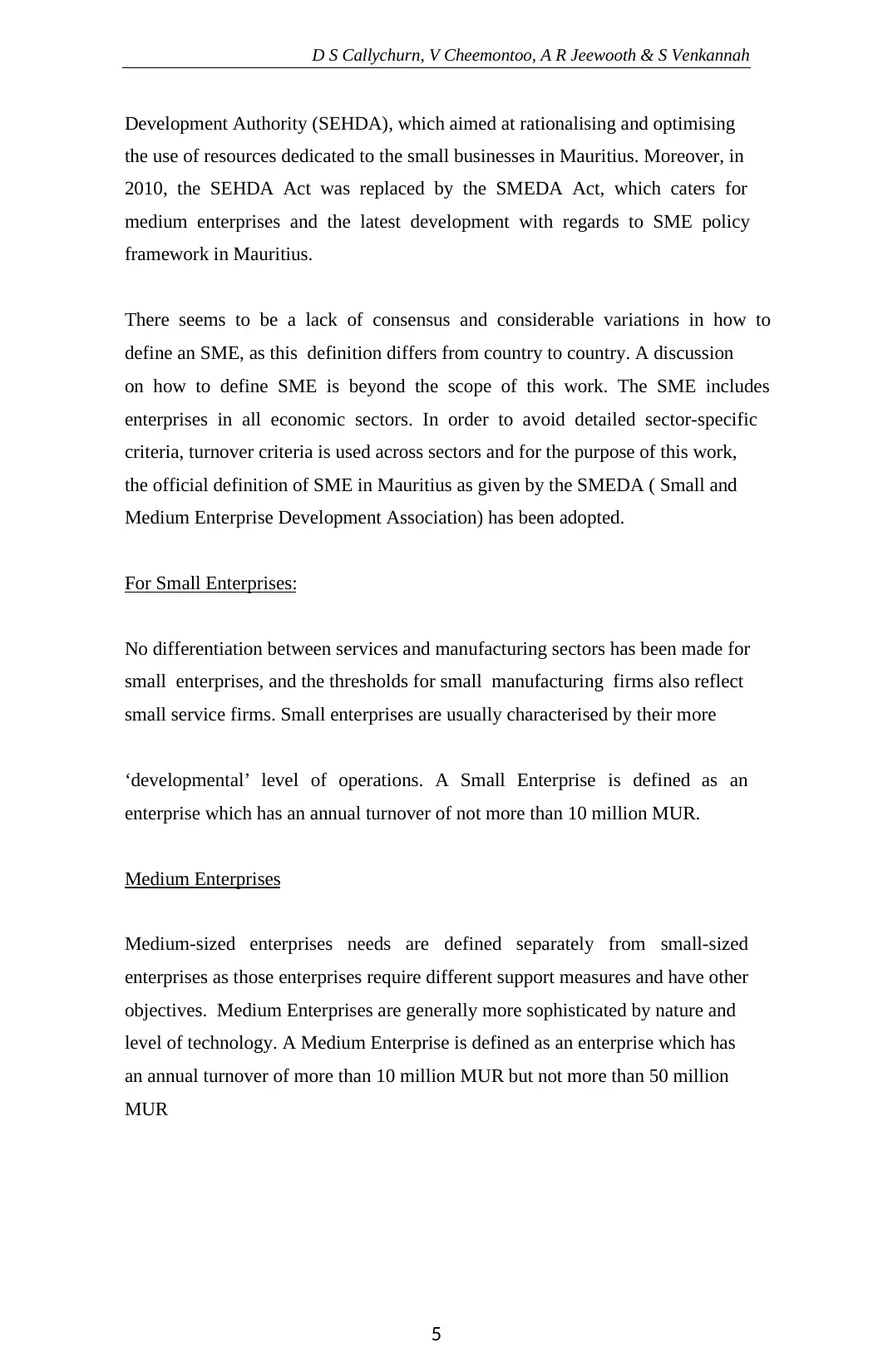
D S Callychurn, V Cheemontoo, A R Jeewooth & S Venkannah
5
Development Authority (SEHDA), which aimed at rationalising and optimising
the use of resources dedicated to the small businesses in Mauritius. Moreover, in
2010, the SEHDA Act was replaced by the SMEDA Act, which caters for
medium enterprises and the latest development with regards to SME policy
framework in Mauritius.
There seems to be a lack of consensus and considerable variations in how to
define an SME, as this definition differs from country to country. A discussion
on how to define SME is beyond the scope of this work. The SME includes
enterprises in all economic sectors. In order to avoid detailed sector-specific
criteria, turnover criteria is used across sectors and for the purpose of this work,
the official definition of SME in Mauritius as given by the SMEDA ( Small and
Medium Enterprise Development Association) has been adopted.
For Small Enterprises:
No differentiation between services and manufacturing sectors has been made for
small enterprises, and the thresholds for small manufacturing firms also reflect
small service firms. Small enterprises are usually characterised by their more
‘developmental’ level of operations. A Small Enterprise is defined as an
enterprise which has an annual turnover of not more than 10 million MUR.
Medium Enterprises
Medium-sized enterprises needs are defined separately from small-sized
enterprises as those enterprises require different support measures and have other
objectives. Medium Enterprises are generally more sophisticated by nature and
level of technology. A Medium Enterprise is defined as an enterprise which has
an annual turnover of more than 10 million MUR but not more than 50 million
MUR
5
Development Authority (SEHDA), which aimed at rationalising and optimising
the use of resources dedicated to the small businesses in Mauritius. Moreover, in
2010, the SEHDA Act was replaced by the SMEDA Act, which caters for
medium enterprises and the latest development with regards to SME policy
framework in Mauritius.
There seems to be a lack of consensus and considerable variations in how to
define an SME, as this definition differs from country to country. A discussion
on how to define SME is beyond the scope of this work. The SME includes
enterprises in all economic sectors. In order to avoid detailed sector-specific
criteria, turnover criteria is used across sectors and for the purpose of this work,
the official definition of SME in Mauritius as given by the SMEDA ( Small and
Medium Enterprise Development Association) has been adopted.
For Small Enterprises:
No differentiation between services and manufacturing sectors has been made for
small enterprises, and the thresholds for small manufacturing firms also reflect
small service firms. Small enterprises are usually characterised by their more
‘developmental’ level of operations. A Small Enterprise is defined as an
enterprise which has an annual turnover of not more than 10 million MUR.
Medium Enterprises
Medium-sized enterprises needs are defined separately from small-sized
enterprises as those enterprises require different support measures and have other
objectives. Medium Enterprises are generally more sophisticated by nature and
level of technology. A Medium Enterprise is defined as an enterprise which has
an annual turnover of more than 10 million MUR but not more than 50 million
MUR
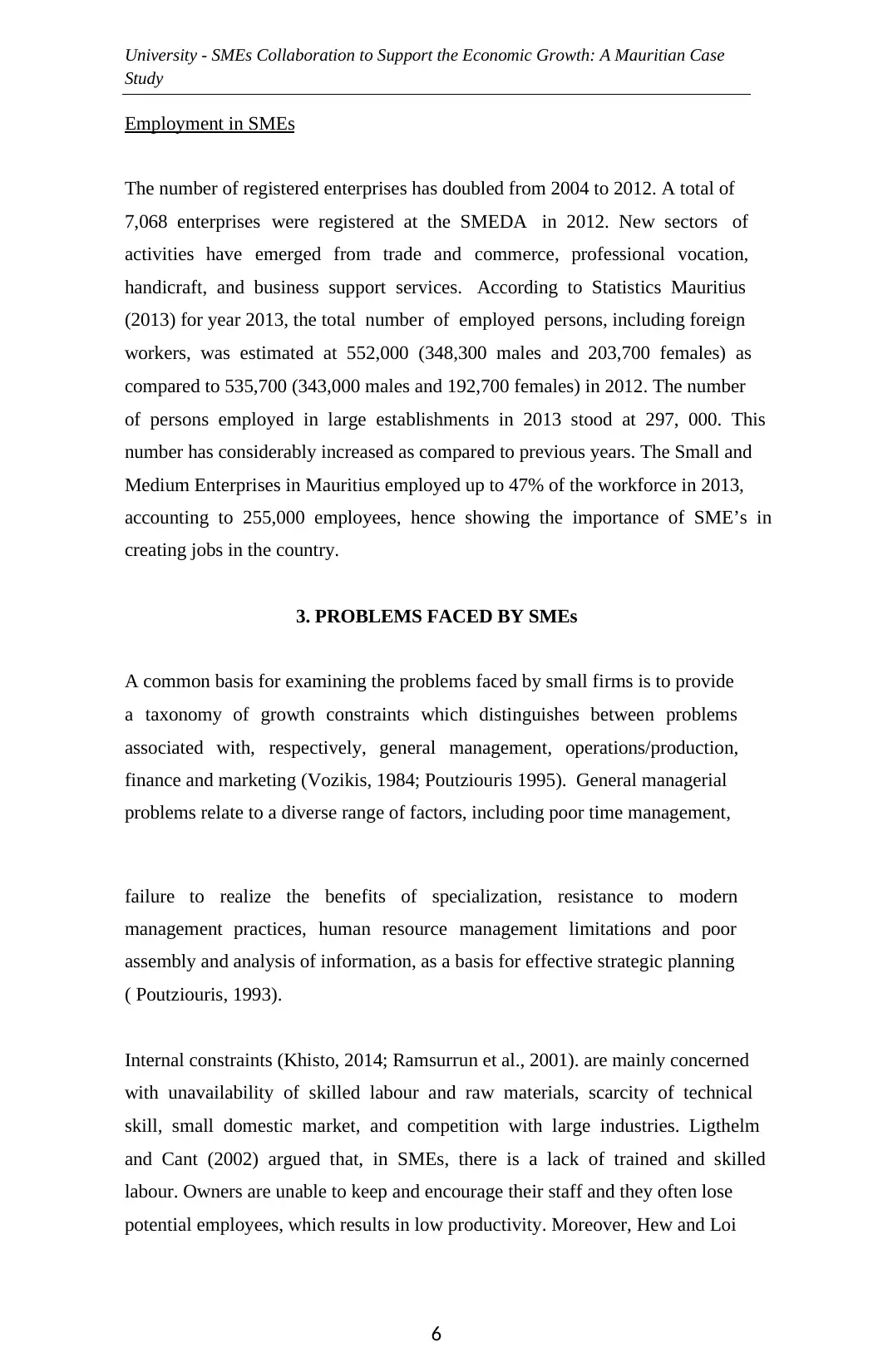
University - SMEs Collaboration to Support the Economic Growth: A Mauritian Case
Study
6
Employment in SMEs
The number of registered enterprises has doubled from 2004 to 2012. A total of
7,068 enterprises were registered at the SMEDA in 2012. New sectors of
activities have emerged from trade and commerce, professional vocation,
handicraft, and business support services. According to Statistics Mauritius
(2013) for year 2013, the total number of employed persons, including foreign
workers, was estimated at 552,000 (348,300 males and 203,700 females) as
compared to 535,700 (343,000 males and 192,700 females) in 2012. The number
of persons employed in large establishments in 2013 stood at 297, 000. This
number has considerably increased as compared to previous years. The Small and
Medium Enterprises in Mauritius employed up to 47% of the workforce in 2013,
accounting to 255,000 employees, hence showing the importance of SME’s in
creating jobs in the country.
3. PROBLEMS FACED BY SMEs
A common basis for examining the problems faced by small firms is to provide
a taxonomy of growth constraints which distinguishes between problems
associated with, respectively, general management, operations/production,
finance and marketing (Vozikis, 1984; Poutziouris 1995). General managerial
problems relate to a diverse range of factors, including poor time management,
failure to realize the benefits of specialization, resistance to modern
management practices, human resource management limitations and poor
assembly and analysis of information, as a basis for effective strategic planning
( Poutziouris, 1993).
Internal constraints (Khisto, 2014; Ramsurrun et al., 2001). are mainly concerned
with unavailability of skilled labour and raw materials, scarcity of technical
skill, small domestic market, and competition with large industries. Ligthelm
and Cant (2002) argued that, in SMEs, there is a lack of trained and skilled
labour. Owners are unable to keep and encourage their staff and they often lose
potential employees, which results in low productivity. Moreover, Hew and Loi
Study
6
Employment in SMEs
The number of registered enterprises has doubled from 2004 to 2012. A total of
7,068 enterprises were registered at the SMEDA in 2012. New sectors of
activities have emerged from trade and commerce, professional vocation,
handicraft, and business support services. According to Statistics Mauritius
(2013) for year 2013, the total number of employed persons, including foreign
workers, was estimated at 552,000 (348,300 males and 203,700 females) as
compared to 535,700 (343,000 males and 192,700 females) in 2012. The number
of persons employed in large establishments in 2013 stood at 297, 000. This
number has considerably increased as compared to previous years. The Small and
Medium Enterprises in Mauritius employed up to 47% of the workforce in 2013,
accounting to 255,000 employees, hence showing the importance of SME’s in
creating jobs in the country.
3. PROBLEMS FACED BY SMEs
A common basis for examining the problems faced by small firms is to provide
a taxonomy of growth constraints which distinguishes between problems
associated with, respectively, general management, operations/production,
finance and marketing (Vozikis, 1984; Poutziouris 1995). General managerial
problems relate to a diverse range of factors, including poor time management,
failure to realize the benefits of specialization, resistance to modern
management practices, human resource management limitations and poor
assembly and analysis of information, as a basis for effective strategic planning
( Poutziouris, 1993).
Internal constraints (Khisto, 2014; Ramsurrun et al., 2001). are mainly concerned
with unavailability of skilled labour and raw materials, scarcity of technical
skill, small domestic market, and competition with large industries. Ligthelm
and Cant (2002) argued that, in SMEs, there is a lack of trained and skilled
labour. Owners are unable to keep and encourage their staff and they often lose
potential employees, which results in low productivity. Moreover, Hew and Loi
⊘ This is a preview!⊘
Do you want full access?
Subscribe today to unlock all pages.

Trusted by 1+ million students worldwide
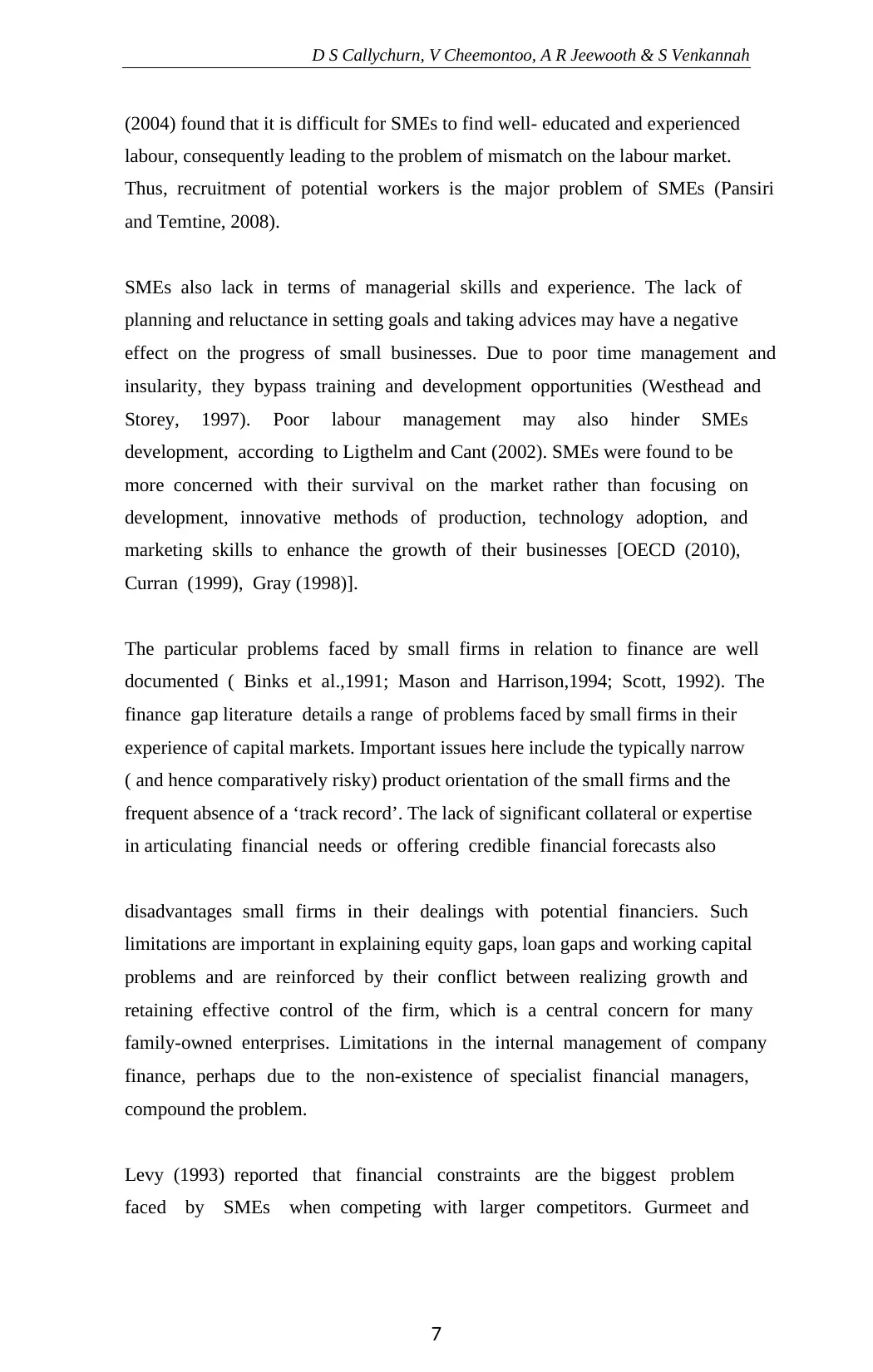
D S Callychurn, V Cheemontoo, A R Jeewooth & S Venkannah
7
(2004) found that it is difficult for SMEs to find well- educated and experienced
labour, consequently leading to the problem of mismatch on the labour market.
Thus, recruitment of potential workers is the major problem of SMEs (Pansiri
and Temtine, 2008).
SMEs also lack in terms of managerial skills and experience. The lack of
planning and reluctance in setting goals and taking advices may have a negative
effect on the progress of small businesses. Due to poor time management and
insularity, they bypass training and development opportunities (Westhead and
Storey, 1997). Poor labour management may also hinder SMEs
development, according to Ligthelm and Cant (2002). SMEs were found to be
more concerned with their survival on the market rather than focusing on
development, innovative methods of production, technology adoption, and
marketing skills to enhance the growth of their businesses [OECD (2010),
Curran (1999), Gray (1998)].
The particular problems faced by small firms in relation to finance are well
documented ( Binks et al.,1991; Mason and Harrison,1994; Scott, 1992). The
finance gap literature details a range of problems faced by small firms in their
experience of capital markets. Important issues here include the typically narrow
( and hence comparatively risky) product orientation of the small firms and the
frequent absence of a ‘track record’. The lack of significant collateral or expertise
in articulating financial needs or offering credible financial forecasts also
disadvantages small firms in their dealings with potential financiers. Such
limitations are important in explaining equity gaps, loan gaps and working capital
problems and are reinforced by their conflict between realizing growth and
retaining effective control of the firm, which is a central concern for many
family-owned enterprises. Limitations in the internal management of company
finance, perhaps due to the non-existence of specialist financial managers,
compound the problem.
Levy (1993) reported that financial constraints are the biggest problem
faced by SMEs when competing with larger competitors. Gurmeet and
7
(2004) found that it is difficult for SMEs to find well- educated and experienced
labour, consequently leading to the problem of mismatch on the labour market.
Thus, recruitment of potential workers is the major problem of SMEs (Pansiri
and Temtine, 2008).
SMEs also lack in terms of managerial skills and experience. The lack of
planning and reluctance in setting goals and taking advices may have a negative
effect on the progress of small businesses. Due to poor time management and
insularity, they bypass training and development opportunities (Westhead and
Storey, 1997). Poor labour management may also hinder SMEs
development, according to Ligthelm and Cant (2002). SMEs were found to be
more concerned with their survival on the market rather than focusing on
development, innovative methods of production, technology adoption, and
marketing skills to enhance the growth of their businesses [OECD (2010),
Curran (1999), Gray (1998)].
The particular problems faced by small firms in relation to finance are well
documented ( Binks et al.,1991; Mason and Harrison,1994; Scott, 1992). The
finance gap literature details a range of problems faced by small firms in their
experience of capital markets. Important issues here include the typically narrow
( and hence comparatively risky) product orientation of the small firms and the
frequent absence of a ‘track record’. The lack of significant collateral or expertise
in articulating financial needs or offering credible financial forecasts also
disadvantages small firms in their dealings with potential financiers. Such
limitations are important in explaining equity gaps, loan gaps and working capital
problems and are reinforced by their conflict between realizing growth and
retaining effective control of the firm, which is a central concern for many
family-owned enterprises. Limitations in the internal management of company
finance, perhaps due to the non-existence of specialist financial managers,
compound the problem.
Levy (1993) reported that financial constraints are the biggest problem
faced by SMEs when competing with larger competitors. Gurmeet and
Paraphrase This Document
Need a fresh take? Get an instant paraphrase of this document with our AI Paraphraser
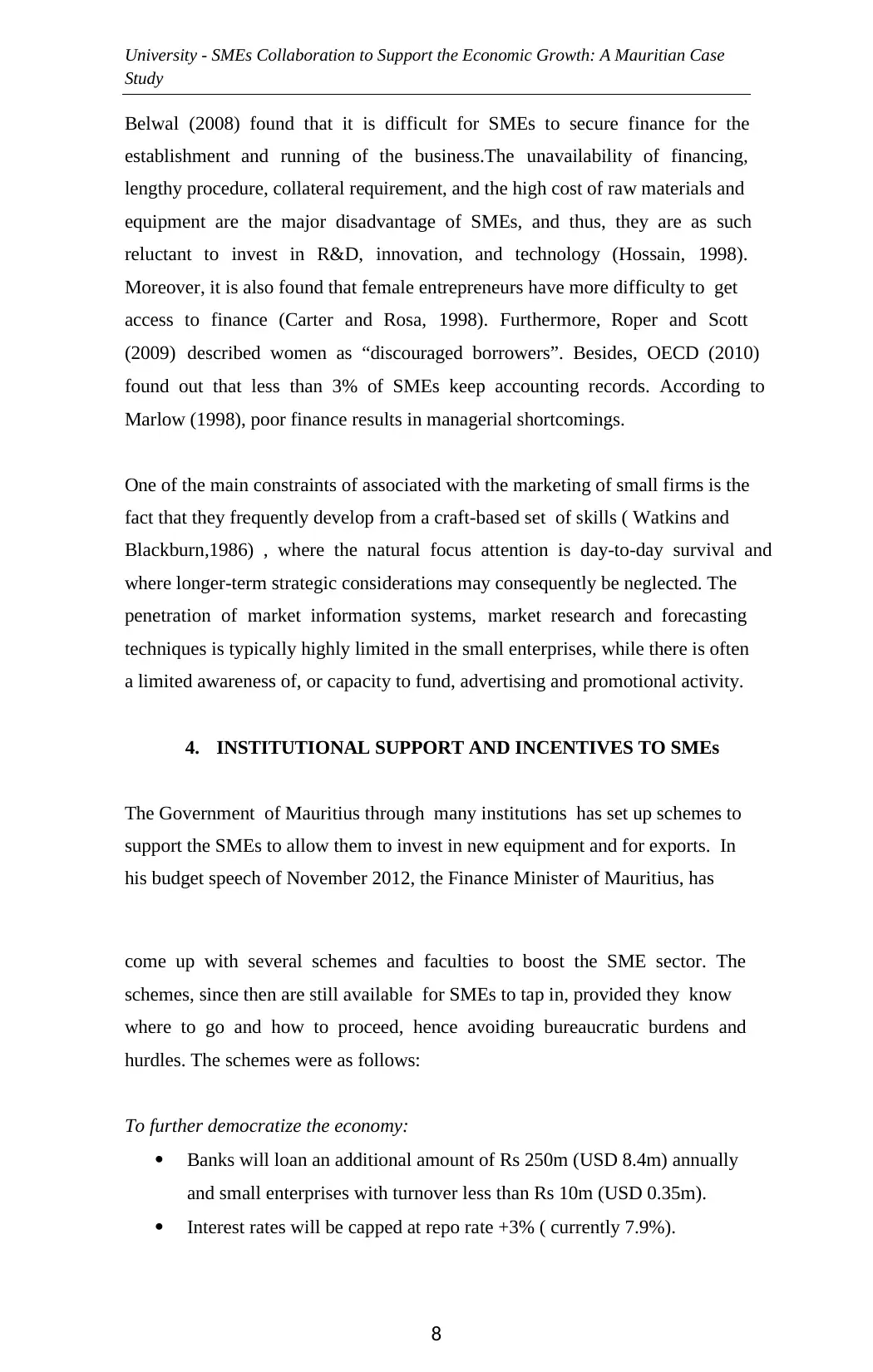
University - SMEs Collaboration to Support the Economic Growth: A Mauritian Case
Study
8
Belwal (2008) found that it is difficult for SMEs to secure finance for the
establishment and running of the business.The unavailability of financing,
lengthy procedure, collateral requirement, and the high cost of raw materials and
equipment are the major disadvantage of SMEs, and thus, they are as such
reluctant to invest in R&D, innovation, and technology (Hossain, 1998).
Moreover, it is also found that female entrepreneurs have more difficulty to get
access to finance (Carter and Rosa, 1998). Furthermore, Roper and Scott
(2009) described women as “discouraged borrowers”. Besides, OECD (2010)
found out that less than 3% of SMEs keep accounting records. According to
Marlow (1998), poor finance results in managerial shortcomings.
One of the main constraints of associated with the marketing of small firms is the
fact that they frequently develop from a craft-based set of skills ( Watkins and
Blackburn,1986) , where the natural focus attention is day-to-day survival and
where longer-term strategic considerations may consequently be neglected. The
penetration of market information systems, market research and forecasting
techniques is typically highly limited in the small enterprises, while there is often
a limited awareness of, or capacity to fund, advertising and promotional activity.
4. INSTITUTIONAL SUPPORT AND INCENTIVES TO SMEs
The Government of Mauritius through many institutions has set up schemes to
support the SMEs to allow them to invest in new equipment and for exports. In
his budget speech of November 2012, the Finance Minister of Mauritius, has
come up with several schemes and faculties to boost the SME sector. The
schemes, since then are still available for SMEs to tap in, provided they know
where to go and how to proceed, hence avoiding bureaucratic burdens and
hurdles. The schemes were as follows:
To further democratize the economy:
Banks will loan an additional amount of Rs 250m (USD 8.4m) annually
and small enterprises with turnover less than Rs 10m (USD 0.35m).
Interest rates will be capped at repo rate +3% ( currently 7.9%).
Study
8
Belwal (2008) found that it is difficult for SMEs to secure finance for the
establishment and running of the business.The unavailability of financing,
lengthy procedure, collateral requirement, and the high cost of raw materials and
equipment are the major disadvantage of SMEs, and thus, they are as such
reluctant to invest in R&D, innovation, and technology (Hossain, 1998).
Moreover, it is also found that female entrepreneurs have more difficulty to get
access to finance (Carter and Rosa, 1998). Furthermore, Roper and Scott
(2009) described women as “discouraged borrowers”. Besides, OECD (2010)
found out that less than 3% of SMEs keep accounting records. According to
Marlow (1998), poor finance results in managerial shortcomings.
One of the main constraints of associated with the marketing of small firms is the
fact that they frequently develop from a craft-based set of skills ( Watkins and
Blackburn,1986) , where the natural focus attention is day-to-day survival and
where longer-term strategic considerations may consequently be neglected. The
penetration of market information systems, market research and forecasting
techniques is typically highly limited in the small enterprises, while there is often
a limited awareness of, or capacity to fund, advertising and promotional activity.
4. INSTITUTIONAL SUPPORT AND INCENTIVES TO SMEs
The Government of Mauritius through many institutions has set up schemes to
support the SMEs to allow them to invest in new equipment and for exports. In
his budget speech of November 2012, the Finance Minister of Mauritius, has
come up with several schemes and faculties to boost the SME sector. The
schemes, since then are still available for SMEs to tap in, provided they know
where to go and how to proceed, hence avoiding bureaucratic burdens and
hurdles. The schemes were as follows:
To further democratize the economy:
Banks will loan an additional amount of Rs 250m (USD 8.4m) annually
and small enterprises with turnover less than Rs 10m (USD 0.35m).
Interest rates will be capped at repo rate +3% ( currently 7.9%).
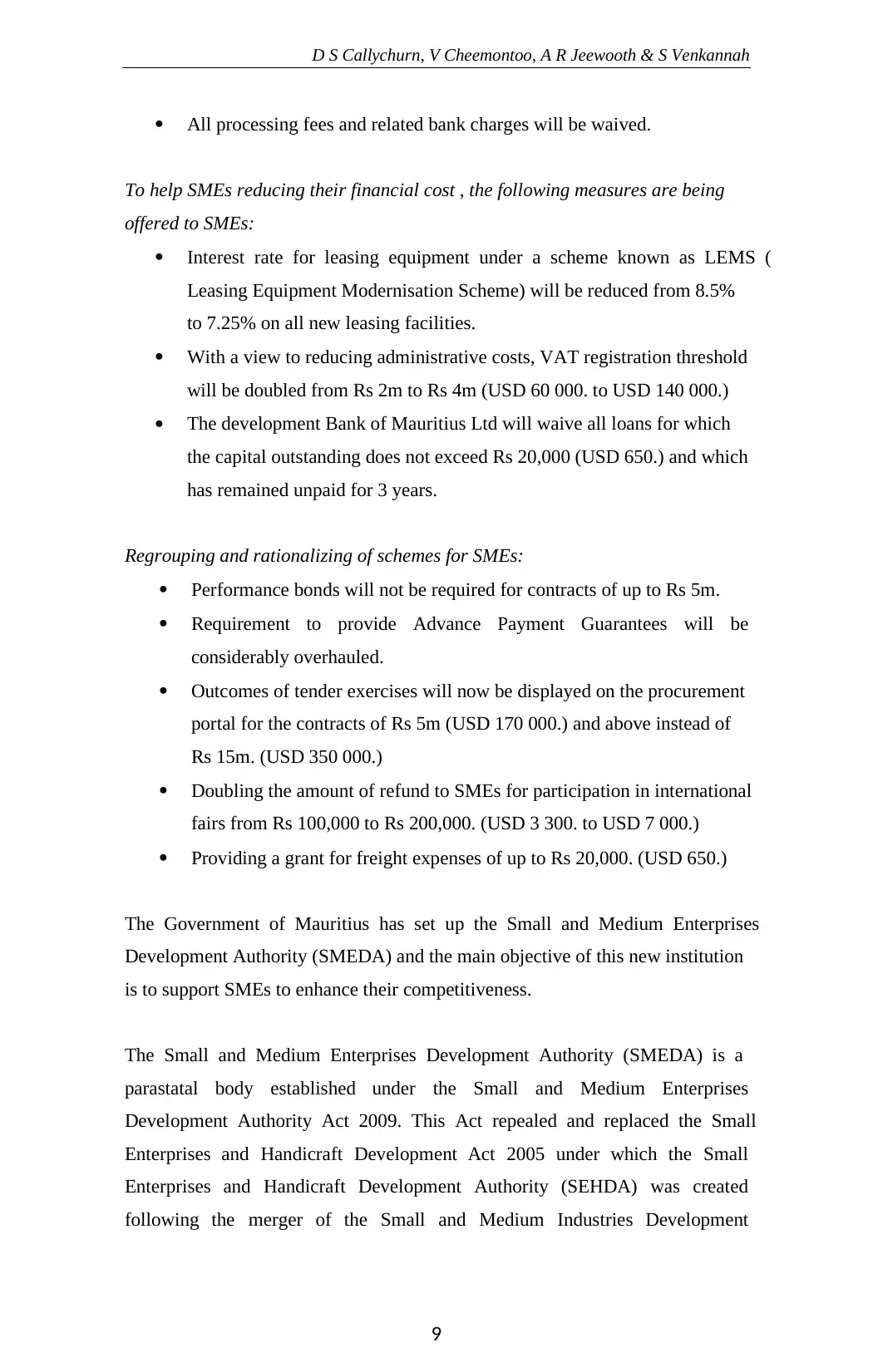
D S Callychurn, V Cheemontoo, A R Jeewooth & S Venkannah
9
All processing fees and related bank charges will be waived.
To help SMEs reducing their financial cost , the following measures are being
offered to SMEs:
Interest rate for leasing equipment under a scheme known as LEMS (
Leasing Equipment Modernisation Scheme) will be reduced from 8.5%
to 7.25% on all new leasing facilities.
With a view to reducing administrative costs, VAT registration threshold
will be doubled from Rs 2m to Rs 4m (USD 60 000. to USD 140 000.)
The development Bank of Mauritius Ltd will waive all loans for which
the capital outstanding does not exceed Rs 20,000 (USD 650.) and which
has remained unpaid for 3 years.
Regrouping and rationalizing of schemes for SMEs:
Performance bonds will not be required for contracts of up to Rs 5m.
Requirement to provide Advance Payment Guarantees will be
considerably overhauled.
Outcomes of tender exercises will now be displayed on the procurement
portal for the contracts of Rs 5m (USD 170 000.) and above instead of
Rs 15m. (USD 350 000.)
Doubling the amount of refund to SMEs for participation in international
fairs from Rs 100,000 to Rs 200,000. (USD 3 300. to USD 7 000.)
Providing a grant for freight expenses of up to Rs 20,000. (USD 650.)
The Government of Mauritius has set up the Small and Medium Enterprises
Development Authority (SMEDA) and the main objective of this new institution
is to support SMEs to enhance their competitiveness.
The Small and Medium Enterprises Development Authority (SMEDA) is a
parastatal body established under the Small and Medium Enterprises
Development Authority Act 2009. This Act repealed and replaced the Small
Enterprises and Handicraft Development Act 2005 under which the Small
Enterprises and Handicraft Development Authority (SEHDA) was created
following the merger of the Small and Medium Industries Development
9
All processing fees and related bank charges will be waived.
To help SMEs reducing their financial cost , the following measures are being
offered to SMEs:
Interest rate for leasing equipment under a scheme known as LEMS (
Leasing Equipment Modernisation Scheme) will be reduced from 8.5%
to 7.25% on all new leasing facilities.
With a view to reducing administrative costs, VAT registration threshold
will be doubled from Rs 2m to Rs 4m (USD 60 000. to USD 140 000.)
The development Bank of Mauritius Ltd will waive all loans for which
the capital outstanding does not exceed Rs 20,000 (USD 650.) and which
has remained unpaid for 3 years.
Regrouping and rationalizing of schemes for SMEs:
Performance bonds will not be required for contracts of up to Rs 5m.
Requirement to provide Advance Payment Guarantees will be
considerably overhauled.
Outcomes of tender exercises will now be displayed on the procurement
portal for the contracts of Rs 5m (USD 170 000.) and above instead of
Rs 15m. (USD 350 000.)
Doubling the amount of refund to SMEs for participation in international
fairs from Rs 100,000 to Rs 200,000. (USD 3 300. to USD 7 000.)
Providing a grant for freight expenses of up to Rs 20,000. (USD 650.)
The Government of Mauritius has set up the Small and Medium Enterprises
Development Authority (SMEDA) and the main objective of this new institution
is to support SMEs to enhance their competitiveness.
The Small and Medium Enterprises Development Authority (SMEDA) is a
parastatal body established under the Small and Medium Enterprises
Development Authority Act 2009. This Act repealed and replaced the Small
Enterprises and Handicraft Development Act 2005 under which the Small
Enterprises and Handicraft Development Authority (SEHDA) was created
following the merger of the Small and Medium Industries Development
⊘ This is a preview!⊘
Do you want full access?
Subscribe today to unlock all pages.

Trusted by 1+ million students worldwide
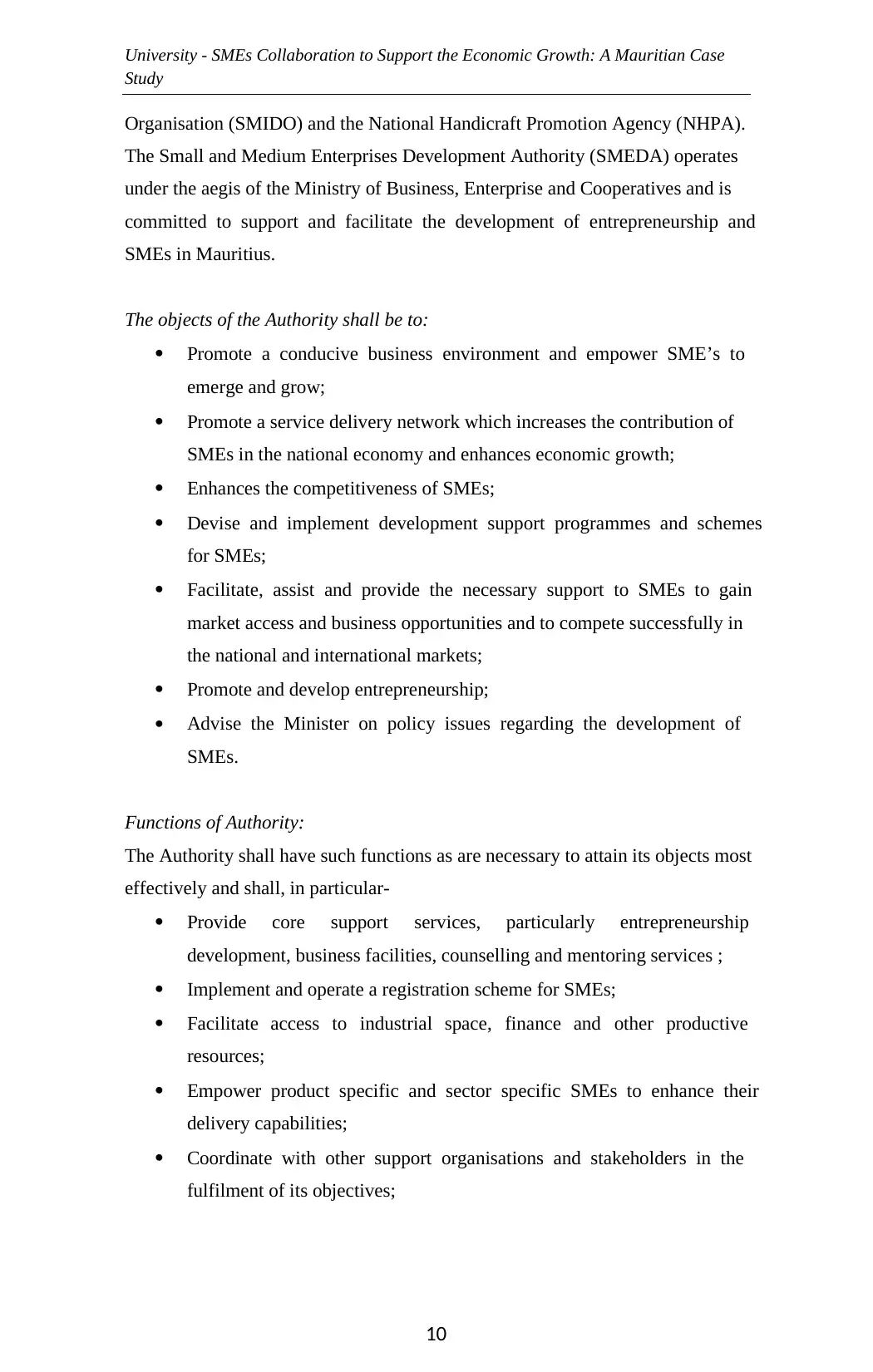
University - SMEs Collaboration to Support the Economic Growth: A Mauritian Case
Study
10
Organisation (SMIDO) and the National Handicraft Promotion Agency (NHPA).
The Small and Medium Enterprises Development Authority (SMEDA) operates
under the aegis of the Ministry of Business, Enterprise and Cooperatives and is
committed to support and facilitate the development of entrepreneurship and
SMEs in Mauritius.
The objects of the Authority shall be to:
Promote a conducive business environment and empower SME’s to
emerge and grow;
Promote a service delivery network which increases the contribution of
SMEs in the national economy and enhances economic growth;
Enhances the competitiveness of SMEs;
Devise and implement development support programmes and schemes
for SMEs;
Facilitate, assist and provide the necessary support to SMEs to gain
market access and business opportunities and to compete successfully in
the national and international markets;
Promote and develop entrepreneurship;
Advise the Minister on policy issues regarding the development of
SMEs.
Functions of Authority:
The Authority shall have such functions as are necessary to attain its objects most
effectively and shall, in particular-
Provide core support services, particularly entrepreneurship
development, business facilities, counselling and mentoring services ;
Implement and operate a registration scheme for SMEs;
Facilitate access to industrial space, finance and other productive
resources;
Empower product specific and sector specific SMEs to enhance their
delivery capabilities;
Coordinate with other support organisations and stakeholders in the
fulfilment of its objectives;
Study
10
Organisation (SMIDO) and the National Handicraft Promotion Agency (NHPA).
The Small and Medium Enterprises Development Authority (SMEDA) operates
under the aegis of the Ministry of Business, Enterprise and Cooperatives and is
committed to support and facilitate the development of entrepreneurship and
SMEs in Mauritius.
The objects of the Authority shall be to:
Promote a conducive business environment and empower SME’s to
emerge and grow;
Promote a service delivery network which increases the contribution of
SMEs in the national economy and enhances economic growth;
Enhances the competitiveness of SMEs;
Devise and implement development support programmes and schemes
for SMEs;
Facilitate, assist and provide the necessary support to SMEs to gain
market access and business opportunities and to compete successfully in
the national and international markets;
Promote and develop entrepreneurship;
Advise the Minister on policy issues regarding the development of
SMEs.
Functions of Authority:
The Authority shall have such functions as are necessary to attain its objects most
effectively and shall, in particular-
Provide core support services, particularly entrepreneurship
development, business facilities, counselling and mentoring services ;
Implement and operate a registration scheme for SMEs;
Facilitate access to industrial space, finance and other productive
resources;
Empower product specific and sector specific SMEs to enhance their
delivery capabilities;
Coordinate with other support organisations and stakeholders in the
fulfilment of its objectives;
Paraphrase This Document
Need a fresh take? Get an instant paraphrase of this document with our AI Paraphraser
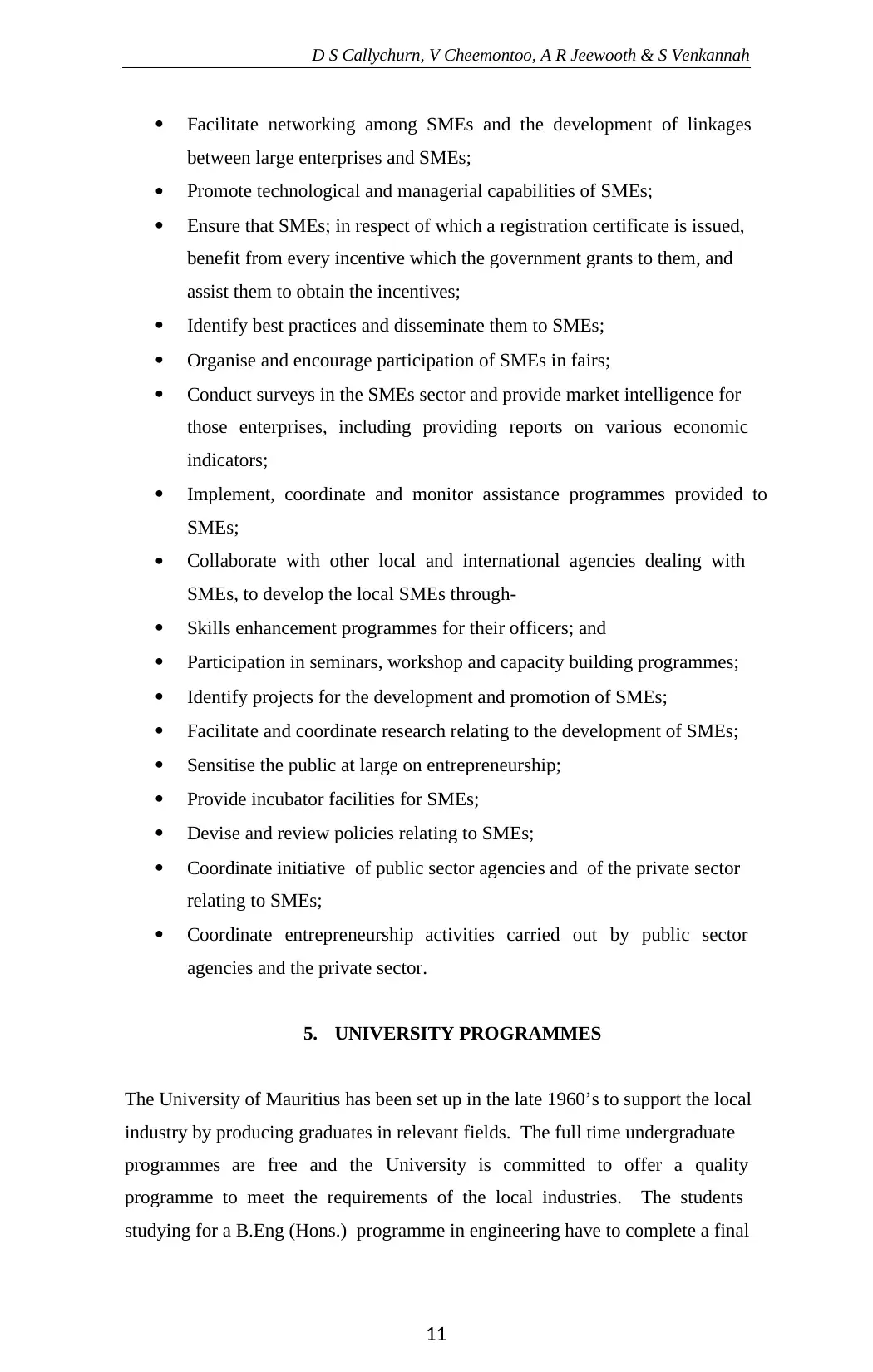
D S Callychurn, V Cheemontoo, A R Jeewooth & S Venkannah
11
Facilitate networking among SMEs and the development of linkages
between large enterprises and SMEs;
Promote technological and managerial capabilities of SMEs;
Ensure that SMEs; in respect of which a registration certificate is issued,
benefit from every incentive which the government grants to them, and
assist them to obtain the incentives;
Identify best practices and disseminate them to SMEs;
Organise and encourage participation of SMEs in fairs;
Conduct surveys in the SMEs sector and provide market intelligence for
those enterprises, including providing reports on various economic
indicators;
Implement, coordinate and monitor assistance programmes provided to
SMEs;
Collaborate with other local and international agencies dealing with
SMEs, to develop the local SMEs through-
Skills enhancement programmes for their officers; and
Participation in seminars, workshop and capacity building programmes;
Identify projects for the development and promotion of SMEs;
Facilitate and coordinate research relating to the development of SMEs;
Sensitise the public at large on entrepreneurship;
Provide incubator facilities for SMEs;
Devise and review policies relating to SMEs;
Coordinate initiative of public sector agencies and of the private sector
relating to SMEs;
Coordinate entrepreneurship activities carried out by public sector
agencies and the private sector.
5. UNIVERSITY PROGRAMMES
The University of Mauritius has been set up in the late 1960’s to support the local
industry by producing graduates in relevant fields. The full time undergraduate
programmes are free and the University is committed to offer a quality
programme to meet the requirements of the local industries. The students
studying for a B.Eng (Hons.) programme in engineering have to complete a final
11
Facilitate networking among SMEs and the development of linkages
between large enterprises and SMEs;
Promote technological and managerial capabilities of SMEs;
Ensure that SMEs; in respect of which a registration certificate is issued,
benefit from every incentive which the government grants to them, and
assist them to obtain the incentives;
Identify best practices and disseminate them to SMEs;
Organise and encourage participation of SMEs in fairs;
Conduct surveys in the SMEs sector and provide market intelligence for
those enterprises, including providing reports on various economic
indicators;
Implement, coordinate and monitor assistance programmes provided to
SMEs;
Collaborate with other local and international agencies dealing with
SMEs, to develop the local SMEs through-
Skills enhancement programmes for their officers; and
Participation in seminars, workshop and capacity building programmes;
Identify projects for the development and promotion of SMEs;
Facilitate and coordinate research relating to the development of SMEs;
Sensitise the public at large on entrepreneurship;
Provide incubator facilities for SMEs;
Devise and review policies relating to SMEs;
Coordinate initiative of public sector agencies and of the private sector
relating to SMEs;
Coordinate entrepreneurship activities carried out by public sector
agencies and the private sector.
5. UNIVERSITY PROGRAMMES
The University of Mauritius has been set up in the late 1960’s to support the local
industry by producing graduates in relevant fields. The full time undergraduate
programmes are free and the University is committed to offer a quality
programme to meet the requirements of the local industries. The students
studying for a B.Eng (Hons.) programme in engineering have to complete a final
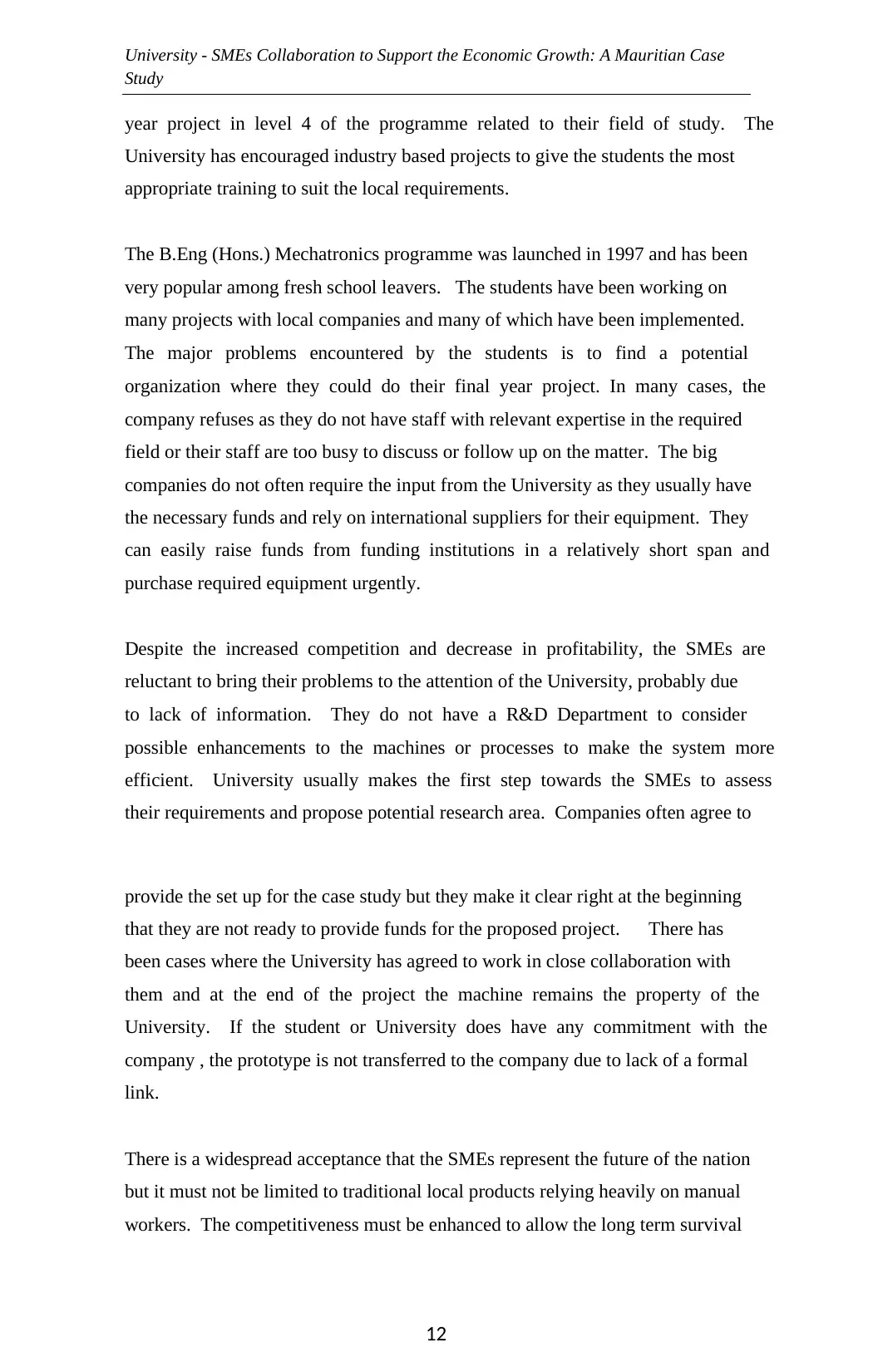
University - SMEs Collaboration to Support the Economic Growth: A Mauritian Case
Study
12
year project in level 4 of the programme related to their field of study. The
University has encouraged industry based projects to give the students the most
appropriate training to suit the local requirements.
The B.Eng (Hons.) Mechatronics programme was launched in 1997 and has been
very popular among fresh school leavers. The students have been working on
many projects with local companies and many of which have been implemented.
The major problems encountered by the students is to find a potential
organization where they could do their final year project. In many cases, the
company refuses as they do not have staff with relevant expertise in the required
field or their staff are too busy to discuss or follow up on the matter. The big
companies do not often require the input from the University as they usually have
the necessary funds and rely on international suppliers for their equipment. They
can easily raise funds from funding institutions in a relatively short span and
purchase required equipment urgently.
Despite the increased competition and decrease in profitability, the SMEs are
reluctant to bring their problems to the attention of the University, probably due
to lack of information. They do not have a R&D Department to consider
possible enhancements to the machines or processes to make the system more
efficient. University usually makes the first step towards the SMEs to assess
their requirements and propose potential research area. Companies often agree to
provide the set up for the case study but they make it clear right at the beginning
that they are not ready to provide funds for the proposed project. There has
been cases where the University has agreed to work in close collaboration with
them and at the end of the project the machine remains the property of the
University. If the student or University does have any commitment with the
company , the prototype is not transferred to the company due to lack of a formal
link.
There is a widespread acceptance that the SMEs represent the future of the nation
but it must not be limited to traditional local products relying heavily on manual
workers. The competitiveness must be enhanced to allow the long term survival
Study
12
year project in level 4 of the programme related to their field of study. The
University has encouraged industry based projects to give the students the most
appropriate training to suit the local requirements.
The B.Eng (Hons.) Mechatronics programme was launched in 1997 and has been
very popular among fresh school leavers. The students have been working on
many projects with local companies and many of which have been implemented.
The major problems encountered by the students is to find a potential
organization where they could do their final year project. In many cases, the
company refuses as they do not have staff with relevant expertise in the required
field or their staff are too busy to discuss or follow up on the matter. The big
companies do not often require the input from the University as they usually have
the necessary funds and rely on international suppliers for their equipment. They
can easily raise funds from funding institutions in a relatively short span and
purchase required equipment urgently.
Despite the increased competition and decrease in profitability, the SMEs are
reluctant to bring their problems to the attention of the University, probably due
to lack of information. They do not have a R&D Department to consider
possible enhancements to the machines or processes to make the system more
efficient. University usually makes the first step towards the SMEs to assess
their requirements and propose potential research area. Companies often agree to
provide the set up for the case study but they make it clear right at the beginning
that they are not ready to provide funds for the proposed project. There has
been cases where the University has agreed to work in close collaboration with
them and at the end of the project the machine remains the property of the
University. If the student or University does have any commitment with the
company , the prototype is not transferred to the company due to lack of a formal
link.
There is a widespread acceptance that the SMEs represent the future of the nation
but it must not be limited to traditional local products relying heavily on manual
workers. The competitiveness must be enhanced to allow the long term survival
⊘ This is a preview!⊘
Do you want full access?
Subscribe today to unlock all pages.

Trusted by 1+ million students worldwide
1 out of 31
Your All-in-One AI-Powered Toolkit for Academic Success.
+13062052269
info@desklib.com
Available 24*7 on WhatsApp / Email
![[object Object]](/_next/static/media/star-bottom.7253800d.svg)
Unlock your academic potential
Copyright © 2020–2025 A2Z Services. All Rights Reserved. Developed and managed by ZUCOL.

